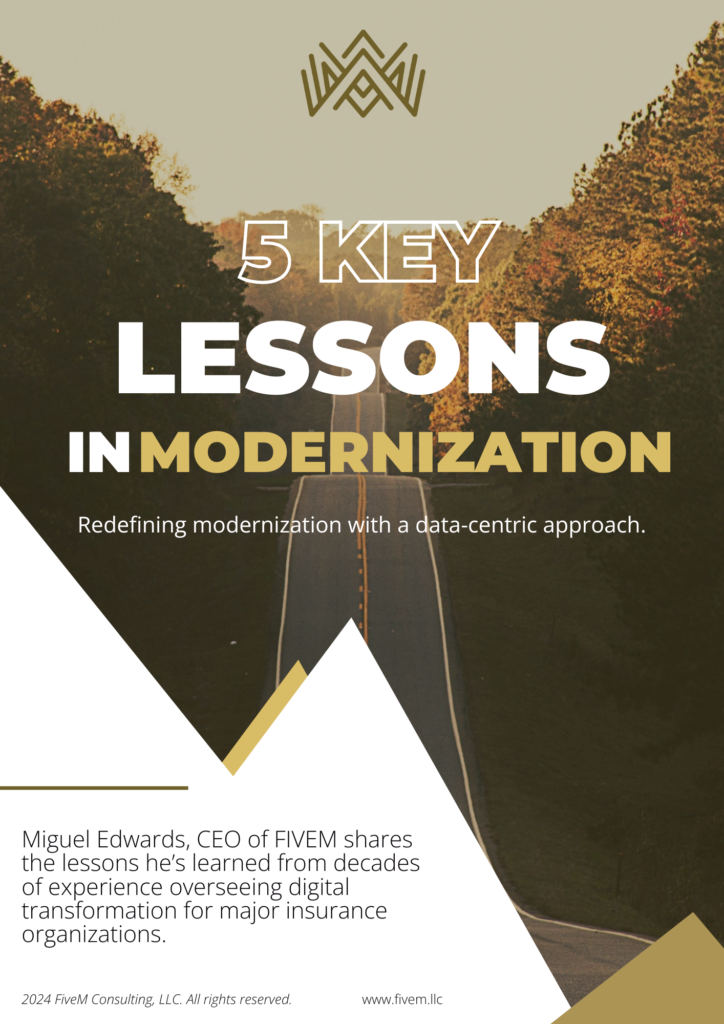Data utilization is often described as the core of the insurance industry. From pricing policies to underwriting and claims processing, every aspect of insurance relies heavily on data. However, the current industry landscape is data-rich but insight-poor, with mountains of data collected daily yet minimal actionable insights derived from it.
The true competitive advantage lies in accessing and leveraging this data effectively. Using data beyond traditional means to offer new services, such as preventative measures that help avoid potential losses, thus improving the company’s resilience.
However, accessing and leveraging data comes with its own set of challenges. Issues such as data governance, lineage, and strategy require substantial effort and funding to address. The alignment between technology and insurance experts is critical to solving these data-related challenges, paving the way for a more efficient and effective utilization of data.
The Challenge of Accessing and Making Data Actionable
One of the most significant hurdles facing the insurance industry today is not the lack of data but the difficulty in making this data actionable. Many companies struggle with the accessibility of their data, often locked in disparate systems that do not communicate with each other. Additionally, there is an immense challenge in converting raw data into actionable insights that can drive decision-making processes.
Simply having access to data does not guarantee a competitive advantage. The key lies in the ability to derive meaningful insights from this data and use it to inform business strategy. This process requires effective data governance, which includes proper identification and tagging of data and ensuring that data is accessible at the right time and place for the right use case.
Moreover, the challenge of making data actionable often involves collaboration and alignment between tech and insurance experts. Only with a concerted effort from both sides can the industry overcome these barriers and begin to leverage data as a true competitive advantage.
The Emergence of AI and Machine Learning in Data Utilization
Artificial Intelligence (AI) and Machine Learning (ML) are revolutionizing how data is utilized in the insurance industry. Whereas traditional methods of data analysis are often slow and labor-intensive, AI and ML can analyze vast amounts of data quickly and accurately, providing insights that would be impossible to obtain otherwise.
The insurance industry is increasingly relying on these technologies to unlock insights from their data. AI and ML algorithms can predict customer behavior, assess risk more accurately, and even identify fraudulent activity. For instance, safe driving rewards programs use technology to monitor driving behavior and adjust insurance premiums accordingly, promoting safer driving habits and reducing overall risk.
Integrating AI and ML into insurance processes presents several challenges. Companies must invest in the necessary technology and expertise to develop and maintain these systems. They also need to ensure their data is of high quality and their AI and ML models are transparent and fair. Insurtech World highlights that successful AI integration in the insurance sector requires clear regulatory guidelines to manage data privacy and model transparency, ensuring ethical and effective use of these technologies. Despite these challenges, the potential benefits of AI and ML make them indispensable tools for the modern insurance industry.
The Importance of Data Governance and Strategy
Effective data governance and strategy are crucial for the successful utilization of data in the insurance industry. Without proper governance, data can become disorganized, leading to inconsistencies and inaccuracies that undermine its value. Furthermore, a robust data strategy is essential for aligning data initiatives with business goals and ensuring that data is used to drive meaningful outcomes.
There is a need for dedicated effort and funding to establish effective data governance. This includes implementing policies and procedures for data management, as well as investing in tools and technologies that facilitate data access and analysis. Proper data governance also involves ensuring that data is accurate, complete, and timely, which is essential for generating reliable insights.
Furthermore, a well-defined data strategy helps organizations to prioritize their data initiatives and focus on areas that will have the greatest impact on their business. This includes identifying key business problems that data can help to solve and ensuring that data initiatives are aligned with the company’s overall goals. By taking a strategic approach to data, insurance companies can maximize the value of their data and gain a competitive edge in the market.
Aligning Data Initiatives with Business Goals
For data to truly add value to an organization, it must be aligned with the company’s business goals. In the insurance industry, this means using data to address specific business challenges and improve profitability. Startups and data science initiatives should be focused on achieving current business objectives, rather than pursuing abstract or theoretical goals.
One example is the use of data to improve customer experience. By analyzing customer data, insurance companies can identify pain points in the customer journey and develop solutions to address them. This can lead to higher customer satisfaction and retention, which ultimately impacts the company’s bottom line.
Additionally, aligning data initiatives with business goals involves holding the Chief Data Officer (CDO) accountable for delivering results. The CDO should have the same level of responsibility and authority as other C-suite executives, and their performance should be measured based on the impact of data initiatives on the company’s business outcomes. By taking this approach, insurance companies can ensure that their data initiatives are focused on delivering tangible value.
Leveraging Data for Preventative Measures
One of the most promising applications of data in the insurance industry is its use for preventative measures. By analyzing data, insurance companies can identify potential risks and take proactive steps to mitigate them. This not only reduces the likelihood of losses but also enhances the overall resilience of the company.
For instance, data on driving behavior can be used to promote safer driving habits through reward programs. Similarly, data utilization for home maintenance can help predict potential issues and encourage homeowners to take preventative actions. These measures not only reduce risk but also improve customer satisfaction by providing added value.
It’s important to use data to develop targeted prevention strategies for different lines of business. For example, the preventative measures for auto insurance may differ significantly from those for home insurance. By tailoring their approach based on data insights, insurance companies can effectively address the unique risks associated with each type of insurance. This not only enhances risk management but also positions the company as a proactive and customer-focused organization.
The Role of the Chief Data Officer
The role of the Chief Data Officer (CDO) is becoming increasingly important in the insurance industry. The CDO is responsible for overseeing the company’s data strategy and ensuring that data utilization initiatives are aligned with business goals. It should be emphasized that the CDO be held accountable for delivering results and have the same level of authority as other C-suite executives.
One of the key challenges facing CDOs is the short runway to provide value before losing support. This means that CDOs must quickly demonstrate the impact of data initiatives on the company’s business outcomes. To achieve this, they need to focus on addressing specific business problems and delivering tangible results. By doing so, they can build credibility and secure ongoing support for their data initiatives.
Furthermore, the CDO plays a critical role in fostering collaboration and alignment between tech and insurance experts. This involves creating a data-driven culture within the organization and ensuring that all stakeholders understand the value of data. The CDO must also ensure that the company has the necessary tools and technologies to access and leverage data effectively. By taking a strategic and results-oriented approach, the CDO can drive significant value for the organization.
Conclusion
Data utilization is the lifeblood of the modern insurance industry, underpinning everything from pricing and underwriting to claims processing and customer experience. However, the true competitive advantage lies not in the possession of data but in its effective utilization. By addressing the challenges of data accessibility and making data actionable, insurance companies can unlock valuable insights that drive business success.
Technological advancements like AI and machine learning are playing a crucial role in transforming how data is used. These technologies enable insurers to analyze vast amounts of data quickly and accurately, providing insights that were previously unattainable. However, effective data governance and a strategic approach to data are essential to maximize the value of these technologies.
Ultimately, the role of the Chief Data Officer is pivotal in driving data utilization initiatives that align with business goals and deliver tangible value. By focusing on specific business problems and fostering a data-driven culture, CDOs can ensure that data initiatives contribute to the company’s success. With the right approach, leveraging data and technology can provide a significant competitive edge in the insurance industry.





